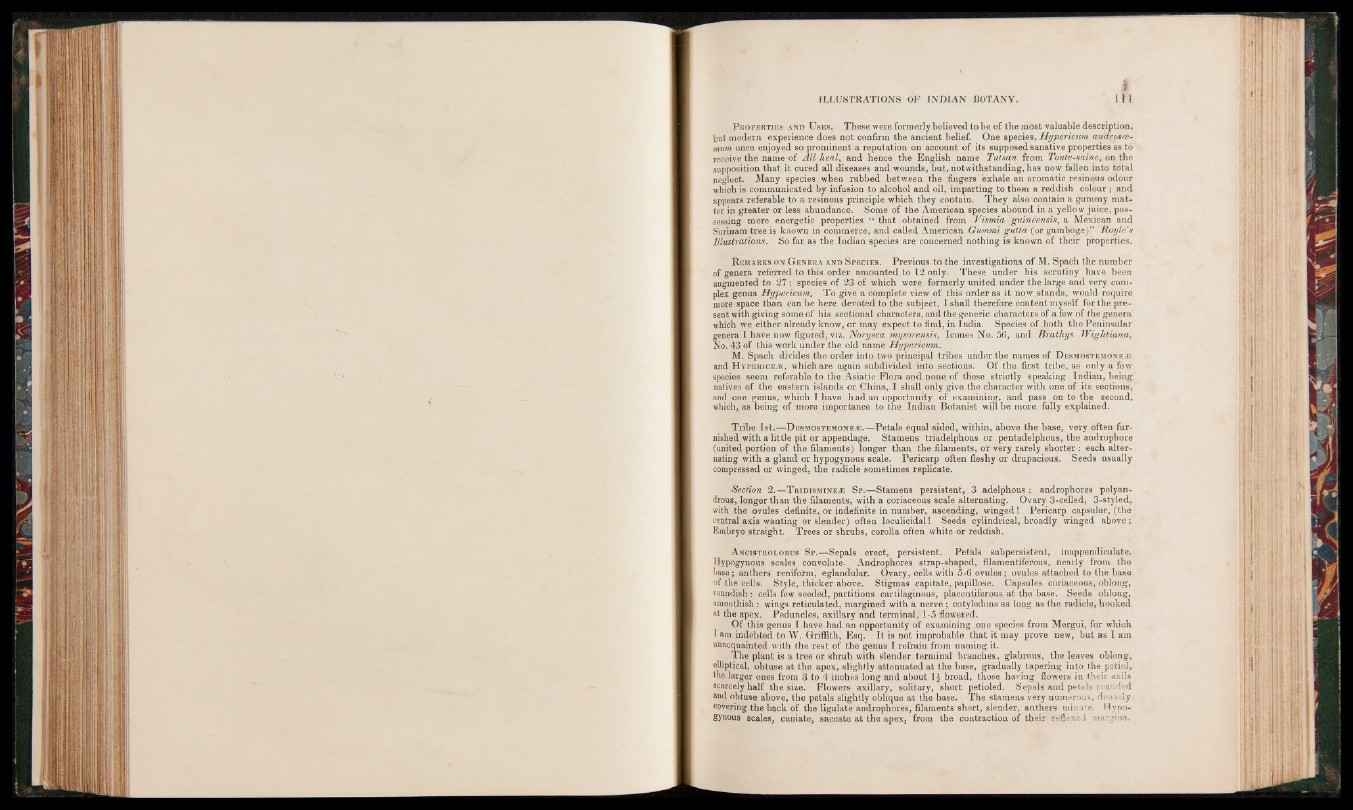
ILLUSTRATIONS OF INDIAN BOTANY.
I
i i i
P rop er t ie s and U se s . These were formerly believed to be of the most valuable description,
hut modern experience does not confirm the ancient belief. One species, Hypericum aridrosce-
mum once enjoyed so prominent a reputation on account of its supposed sanative properties as to
receive the name of Ail heal, and hence the English name. Tutsan from Toute-saine, on the
supposition that it cured all diseases and wounds, but, notwithstanding, has now fallen into total
neglect. Many species when rubbed between the fingers exhale an aromatic resinous odour
which is communicated by infusion to alcohol and oil, imparting to them a reddish colour ; and
appears referable to a resinous principle which they contain. They also'contain a gummy matter
in greater or less abundance. Some of the American species abound in a yellow juice, possessing
more energetic properties “ that obtained from Vismia guineensis, a Mexican and
Surinam tree is known in commerce, and called American Gummi gutta (or gamboge)” Hoyle's
Illustrations. So far as the Indian species are concerned nothing is known of their properties.
R emarks on G enera and S pec ie s . Previous to the investigations of M. Spach the number
of genera referred to this order amounted to 12 only. These under his scrutiny have been
augmented to 27 : species of 23 of which were formerly united under the large and very complex
genus Hypericum. To give a complete view of this order as it now stands, would require
more space than can be here devoted to the subject, I shall therefore content myself for the present
with giving some of his sectional characters, arid the generic characters of a few of the genera
which we either already know, or may expect to find, in India. Species of both the Peninsular
genera I have now figured, viz. Norysca mysorensis, leones No. 56, and Bralhys Wightiana,
No. 43 of this work under the old name Hypericum.
M. Spach divides the order into two principal tribes under the names of D esmostemone.cE
and H y p er ic e® , which are again subdivided into sections. Of the first tribe, as only a few
species seem referable to the Asiatic Flora and none of these strictly speaking Indian, being
natives of the eastern islands or China, I shall only give the character with one of its sections,
and one genus, which I have h ad an opportunity of examining, and pass on to the second,
which, as being of more importance to the Indian Botanist will be more fully explained.
Tribe 1st.—D esmostemone® .—Petals equal sided, within, above the base, very often furnished
with a little pit or appendage. Stamens triadelphous or pentadelphous, the androphore
(united portion of the filaments) longer than the filaments, or very rarely shorter : each alternating
with a gland or hypogynous scale. Pericarp often fleshy or drupacious. Seeds usually
compressed or winged, the radicle sometimes replicate.
Section 2.—T rid ism ine® S p.—Stamens persistent, 3 adelphous ; androphores polyan-
drous, longer than the filaments, with a coriaceous scale alternating. Ovary 3-celled, 3-styIed,
with the ovules definite, or indefinite in number, ascending, winged! Pericarp capsular, (the
central axis wanting or slender) often loculicidal! Seeds cylindrical, broadly winged above;
Embryo straight. Trees or shrubs, corolla often white or reddish.
A ncistrolobus S p .—Sepals erect, persistent. Petals subpersistent, inappendiculate.
Hypogynous scales convolute. Androphores strap-shaped, filamentiferous, nearly from the
base; anthers reniform, eglandular. Ovary, cells with 5-6 ovules; ovules attached to the base
of the cells. Style, thicker above. Stigmas capitate, papillose. Capsules coriaceous, oblong,
roundish : cells few seeded, partitions cartilaginous, placentiferous at the base. Seeds oblong,
smoothish: wings reticulated, margined with a nerve; cotyledons as long as the radicle, hooked
at the apex. Peduncles, axillary and terminal, 1-5 flowered.
Of this genus I have had an opportunity of examining one species from Mergui, for which
I am indebted to W. Griffith, Esq. It is not improbable that it may prove new, but as I am
unacquainted with the rest of the genus I refrain from naming it.
The plant is a tree or shrub with slender terminal branches, glabrous, the leaves oblong,
elliptical, obtuse at the apex, slightly attenuated at the base, gradually tapering into the petiol,
the larger ones from 3 to 4 inches long and about IJ broad, those having flowers in their axils
scarcely half the size. Flowers axillary, solitary, short petioled. Sepals and petals rounded
and obtuse above, the petals slightly oblique at the base. The stamens very numerous, densely
covering the back of the ligulate androphores, filaments short, slender, anthers minute. Hypogynous
scales, cuniate, saccate at the apex, from the contraction of their reflexed margins.